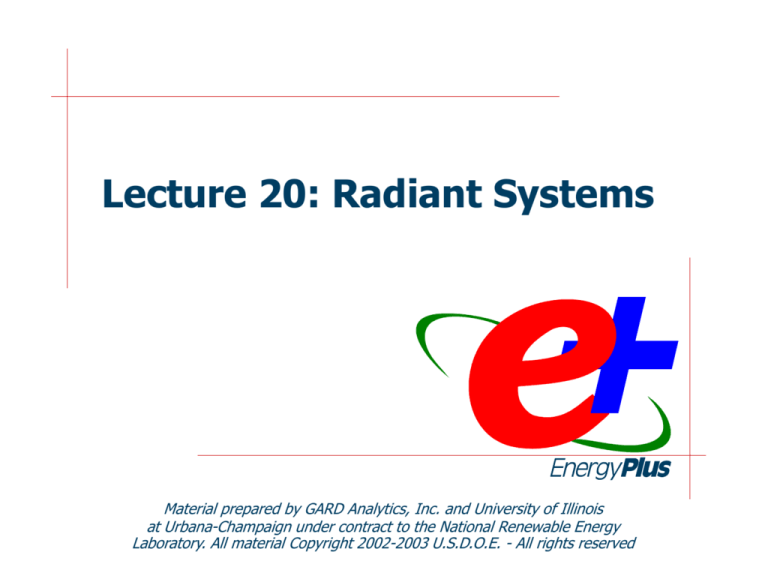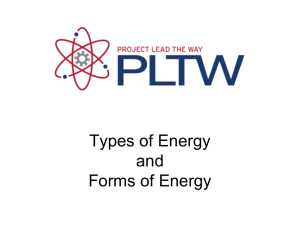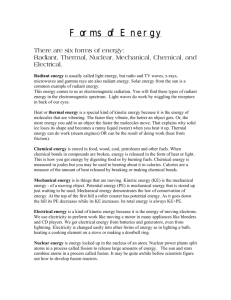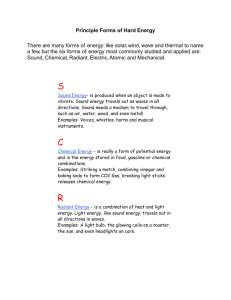
Lecture 20: Radiant Systems
Material prepared by GARD Analytics, Inc. and University of Illinois
at Urbana-Champaign under contract to the National Renewable Energy
Laboratory. All material Copyright 2002-2003 U.S.D.O.E. - All rights reserved
Importance of this Lecture to the
Simulation of Buildings
Forced air systems tend to dominate the US
market
Systems are relatively easy to understand
Control on air temperature pretty straightforward
Air systems do not guarantee comfort which
is a function of other variables besides air
temperature
Other systems, such as radiant systems, may
be a better option for some cases
Ability to simulate different system types is
critical to the fair and accurate comparison of
energy consumption
2
Purpose of this Lecture
Gain an understanding of:
Radiant systems overview: characteristics,
types, advantages, and potential problems
How to specify different types of radiant
systems in EnergyPlus
3
Keywords Covered in this Lecture
Low Temp Radiant System:Hydronic
Construction With Internal Source
Surface:HeatTransfer (review)
Radiant System Surface Group
Low Temp Radiant System:Electric
High Temp Radiant System
4
Radiant Systems Overview
Low Temperature Radiant Systems
High Temperature Radiant Systems
Hybrid Systems
Radiant System Overview
Conventional Forced Air Systems: aim to affect the
thermal comfort of space occupants by conditioning
air and delivering it to a space
Primary effect is on space air temperature
Controls are simple but do not always guarantee comfort
Radiant Systems: aim to affect the thermal comfort of
space occupants by modifying the radiant field within
a space
Primary effect can be on surface temperatures
Some systems are simply direct radiant sources
Controls are more complex but inclusion of radiant effects
may result in better comfort at lower air temperatures
6
Radiant System Overview
(cont’d)
Definition: system which supplies a majority of its
energy to a space via radiation
Main System Types (Temperature Classifications)
Low Temperature Radiant Systems
High (and Medium) Temperature Radiant Systems (heating
only)
Indoor Air Quality (IAQ) Issues
IAQ linked to introduction of outside air, but radiant systems
lack an air stream
Dust, dirt, etc. not spread around by forcing air circulation
IAQ concerns may require the use of a “hybrid” system
7
Radiant System Overview
(cont’d)
Overall Advantages
Less extreme water conditions
Lack of architectural effect
Potential energy savings
Warm floor effect
Market Issues
While gaining in popularity in US, market percentage is still fairly
small (lack of knowledge/understanding about systems, IAQ
concerns)
Much more popular in Asia and Europe where it is used in much
more diverse settings (not just residences)
Safety/Comfort Issues
Concerns about high temperature surfaces within space (burns,
fires)
Limits on wall, floor temperatures (maximum
8
Low Temperature Radiant
Systems
System components
Thermostat (air, radiant, or “operative”)
Radiant surface (embedded in a particular building element)
Resistance wires or water tubing
Control valves and headers
Primary system (boiler/chiller)
System classifications
Hydronic (water, air also possible) or electric
Heat source/sink embedded in a surface: floor, wall, ceiling,
or panel
High mass or low mass
Heating or cooling (hydronic only) though only one at a time
(like a two-pipe air system)
9
Low Temperature Radiant
Systems (cont’d)
Energy efficiency issues
Conditioning surfaces not air—may allow more extreme air
temperatures while maintaining the same amount of comfort
No fan energy
More “extreme” air temperatures should result in less
infiltration heat gain/loss
Heat gain/loss through surfaces—more or less?
Back and edge losses—may require more insulation
Choice of floor covering might decrease system efficiency
Condensation potential (indoor rain)—cooling systems may
require an air loop to avoid moisture condensing on the
system
10
Low Temperature Radiant
Systems (cont’d)
Alternative energy sources
Standard source for heating/cooling system is a boiler or
chiller
Potential for using alternative energy sources may be higher
than with conventional systems due to less extreme water
conditions
Use of mass to shift energy needs
Link to solar hot water heaters (interior or exterior)
Link to ground loop
Link to cooling tower/evaporative cooler (cooling only)
Nighttime ventilation (ventilated slab)
Link to a nearby water source (pond, lake, stream, etc.)
11
Low Temperature Radiant
Systems (cont’d)
Applications
Many—typically used most often in residential
Buildings where warm floors are beneficial (e.g.,
garages)
Buildings where air systems might contaminate
(other) areas (hospitals, clean rooms, etc.)
Buildings where IAQ obtained with minimal air
systems
Snow/ice melting
12
High Temperature Radiant
Systems
General characteristics
Also known as “Infrared Radiant Heating”
High temperature due to characteristic temperatures of
radiant heaters (range from 150 to 2760C)
Low- and medium-intensity (up to ~1000C) typically
gas-fired
High-intensity (above 1000C) use electric resistance
heating
Highly directional in nature—generally good for spot heating
Can result in spaces with highly variable levels of
thermal comfort
Direction depends on type, reflector, and shape
Shapes: tube or lamp
Heating only—cooling would be provided by some other
means
13
High Temperature Radiant
Systems (cont’d)
System components
Burner or wire/filament
Housing (shape depends on type)
Reflector (redirects radiation toward space
Power connection or gas inlet/combustion
exhaust
14
High Temperature Radiant
Systems (cont’d)
Energy efficiency issues
Similar benefits as low temperature radiant heaters: lower
air temperatures and no fan energy
Not all radiation is infrared—some might actually go “out the
window”
Safety issues of the high temperature surface within a space
Applications
Large spaces: hangars, factories, warehouses, gymnasiums
Open areas: loading docks, outdoor areas (stadiums or
restaurants), pools, building entrances
Snow/ice melting
15
Hybrid Systems: Cool Beam
Shaped and positioned like a high
temperature radiant heater but supplied with
chilled water (from plant or alternate source)
Condensate pan to avoid temporary dripping
into space
Air movement via buoyancy effects or small
fan
Some radiant effect
16
Hybrid Systems: Combined
Forced Air/Radiant System
Sometimes referred to as a “hybrid” system
Usually due to condensation or perhaps for IAQ concerns
Radiant system is run as the primary system for heating and
cooling
In cooling mode, forced air loop turns on when condensation
likely (based on moisture levels in the air)
Chilled water sent to forced air coil first and then to radiant
system (to help avoid condensation in the space)
Benefits of radiant system but initial costs of two systems
17
Hybrid Systems: UFAD
Sort of a “pseudo-radiant” system
Underfloor air distribution (floor supply
plenum) can turn the floor into a radiant
system—in effect a hybrid system
Exact effect on comfort not yet studied
since technology is still fairly new
18
Radiant Systems in
EnergyPlus
Radiant System Overview
Low Temperature Radiant Systems
Two types:
Hydronic (must be hooked up to a fluid loop—plant or
condenser)
Electric
System serves as:
Heat transfer surface with an embedded source or sink
(heating or cooling)
Space conditioning system
Important keywords:
Construction With Internal Source
Surface:HeatTransfer
Low Temp Radiant System:Hydronic
Low Temp Radiant System:Electric
Radiant System Surface Group
20
Radiant System Overview
(cont’d)
High Temperature Radiant Systems
Two types:
Electric
Gas
System is only seen as a space
conditioning (heating) system
Important keywords:
High Temp Radiant System
Radiant System Surface Group
21
Radiant System Controls
Thermostatic control
Zone Thermostat determines
whether system is in heating,
cooling, or “float” mode
If zone thermostat says the
system is on, the radiant
temperature schedule
determines the response of the
system
System fluid flow varies linearly
around the setpoint
temperature (user also specifies
a throttling range
Fluid loop temperature
controlled by plant/condenser
loop
Mass Flow
Rate
Setpoint Temperature
Heating
Controlling
Temperature
Throttling Range
Mass Flow
Rate
Setpoint Temperature
Cooling
Controlling
Temperature
Throttling Range
22
Radiant System Controls (cont’d)
Control temperature
In determining the system response, the radiant
control setpoint can be compared to a variety of
other temperatures depending on the type of
control one desires:
Zone Mean Air Temperature
Zone Mean Radiant Temperature
Zone Operative Temperature (average of MAT and MRT)
Outside Air Dry-Bulb Temperature (low temperature
systems only)
Outside Air Wet-Bulb Temperature (low temperature
systems only)
23
Radiant System Controls (cont’d)
Single Surface or Serial Control
Radiant system description for each individual surface
Control is staged via priority in zone equipment list
Top priority surface will attempt to meet entire load; when it
cannot, next highest priority surface will attempt to meet
load, etc.
Multiple Surface or Parallel/Coordinated Control
One radiant system description for a group of surfaces
Control of all surfaces in this group are identical
Split of fluid flow determined by Radiant System Surface
Group input
RADIANT SYSTEM SURFACE GROUP,
Zone 1 Rad Surfs,
Zn001:Flr001,
0.75,
Zn001:Roof001,
0.25;
!!!!!-
name of surface list
Surface name 1
Flow fraction for surface 1
Surface name 2
Flow fraction for surface 224
Low Temperature Surface Input
IDF Example:
CONSTRUCTION WITH INTERNAL SOURCE,
Slab Floor with Radiant, !- Name
3,
!- Source present after this layer in definition below
4,
!- Temperature calculation requested after this layer
1,
!- Dimensions for the CTF calculation (1- or 2-D)
0.1524, !- Tube Spacing {m}
CONCRETE - DRIED SAND AND GRAVEL 4 IN,
!- Outside Layer
INS - EXPANDED EXT POLYSTYRENE R12 2 IN, !- Layer #2
GYP1,
!- Layer #3
GYP2,
!- Layer #4
FINISH FLOORING - TILE 1 / 16 IN;
!- Layer #5
Based on the above input, the tubing (and thus the heat
source or sink) would be applied between layers 3 and 4 in
this construction
25
Low Temperature Surface Input
(cont’d)
IDF Example:
Surface:HeatTransfer,
Zn002:Flr001,
!- User Supplied Surface Name
Floor,
!- Surface Type
Slab Floor with Radiant, !- Construction Name of the Surface
EAST ZONE,
!- Inside Face Environment
Ground,
!- Outside Face Environment
,
!- Outside Face Environment Object
NoSun,
!- Sun Exposure
NoWind,
!- Wind Exposure
1.000000,
!- View Factor to Ground
4, !- Number of Surface Vertice Groups -- Number of (X,Y,Z) group
6.096,0.0,0.0,
!- X,Y,Z ==> Vertex 1
6.096,6.096,0.0,
!- X,Y,Z ==> Vertex 2
12.192,6.096,0.0,
!- X,Y,Z ==> Vertex 3
12.192,0.0,0.0;
!- X,Y,Z ==> Vertex 4
26
Hydronic Radiant Input
IDF Example:
Could be name of a Radiant System Surface Group
LOW TEMP RADIANT SYSTEM:HYDRONIC,
East Zone Radiant Floor, !- name of hydronic low temperature radiant system
RadiantSysAvailSched,
!- availability schedule
East Zone,
!- Zone name (name of zone system is serving)
Zn002:Flr001, !- Surface name (name of surface tubes embedded in) or list name
0.012,
!- Hydronic tubing inside diameter {m}
400.0,
!- Hydronic tubing length (total length of pipe embedded) {m}
MAT,
!- temperature control type (MAT|MRT|OPERATIVE|ODB|OWB)
0.00008,
!- maximum hot water flow {m3/s}
East Zone Radiant Water Inlet Node, !- heating water inlet node
East Zone Radiant Water Outlet Node, !- heating water outlet node
2.0,
!- heating control throttling range {C}
Radiant Heating Setpoints,
!- heating control temperature schedule
0.0012,
!- maximum cold water flow {m3/s}
Zone 2 Cooling Water Inlet Node,
!- cooling water inlet node
Zone 2 Cooling Water Outlet Node,
!- cooling water outlet node
2.0,
!- cooling control throttling range {C}
Radiant Cooling Setpoints;
!- cooling control temperature schedule
Separate input for heating and cooling
27
Electric Low Temperature
Radiant Heating Systems
IDF Example:
LOW TEMP RADIANT SYSTEM:ELECTRIC,
Zone 1 Elec Floor, !- name of electric low temperature radiant system
RadPanelAvailSched, !- availability schedule
NORTH ZONE,
!- Zone name (name of zone system is serving)
Zone 1 Rad Surfs,
!- Surface name or Radiant System Surface Group name
10000,
!- maximum electrical power to panel {W}
MRT,
!- temperature control type (MAT|MRT|Operative|ODB|OWB)
2.0,
!- heating throttling range {C}
Radiant Heating Setpoints; !- heating setpoint temperature schedule
Note: Input similar to hydronic radiant
system except no fluid loop information
and no cooling information
28
High Temperature Radiant
Systems
Affects thermal comfort directly, then convected to zone air
IDF Example:
Energy has no effect on zone or any surface
HIGH TEMP RADIANT SYSTEM,
Zone 1 Radiant Heater, !- name of high temperature radiant system
RadiantPanelAvailSched, !- availability schedule
NORTH ZONE,
!- Zone name (name of zone system is serving)
10000, !- maximum power input {W}
GAS,
!- type of high temperature radiant heater (GAS|ELECTRIC)
0.85, !- combustion efficiency (ignore for electric radiant heaters)
0.75, !- fraction of input converted to radiant energy
0.00, !- fraction of input converted to latent energy
0.00, !- fraction of input that is lost (vented to outside environment)
OPERATIVE,
!- temperature control type (MAT|MRT|OPERATIVE)
2.0,
!- heating throttling range {C}
Radiant Heating Setpoints, !- heating setpoint temperature schedule
0.05, !- fraction of radiant energy incident on people
Zn001:Flr001, !- surface to which radiant energy from heater is distributed
0.75, !- fraction of radiant energy from heater distributed to surface
Zn001:Wall001, !- surface to which radiant energy from heater is distributed
0.25; !- fraction of radiant energy from heater distributed to surface
User-defined output pattern, fraction must add to 1
29
Summary
Radiant systems use radiation as the primary
mode of heat transfer to heat space
occupants directly rather than indirectly by
conditioning air
Low and high temperature radiant systems
can be defined in EnergyPlus as zone
equipment
Hydronic radiant systems are connected to a
primary system loop much like a water coil
30






